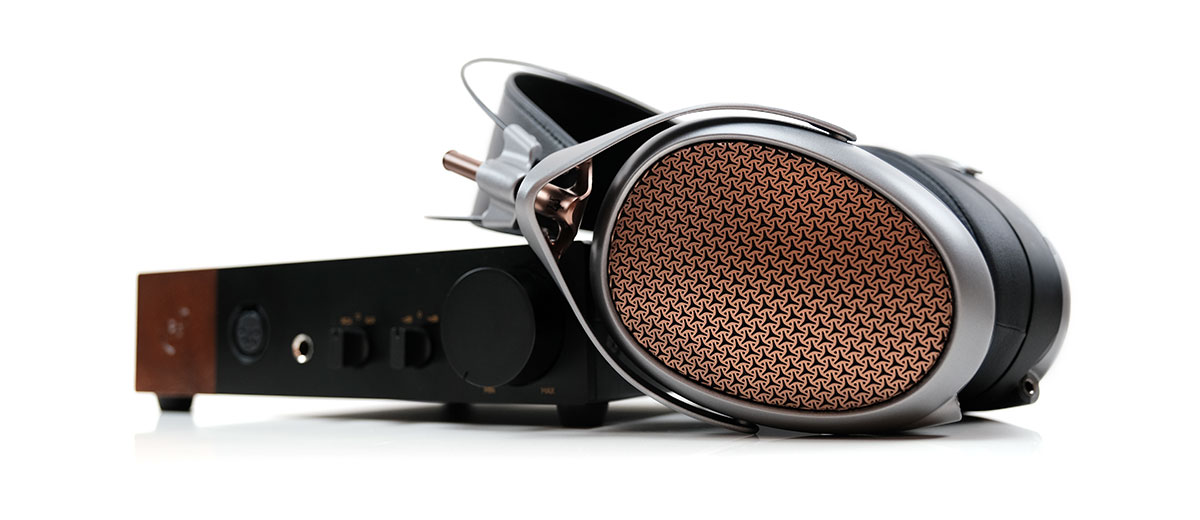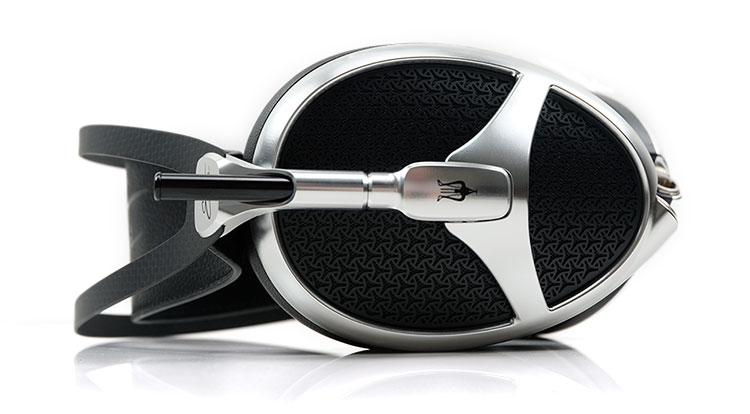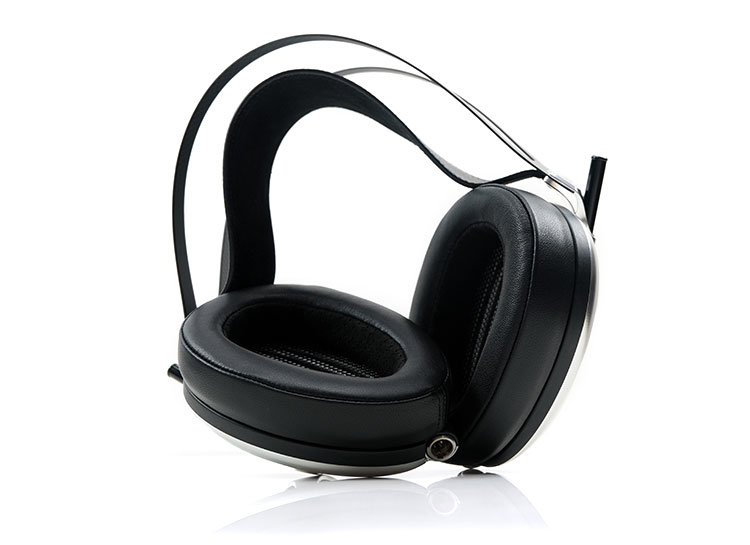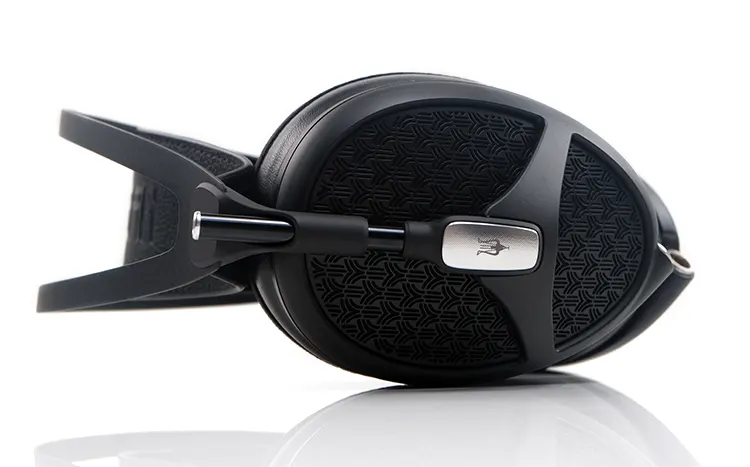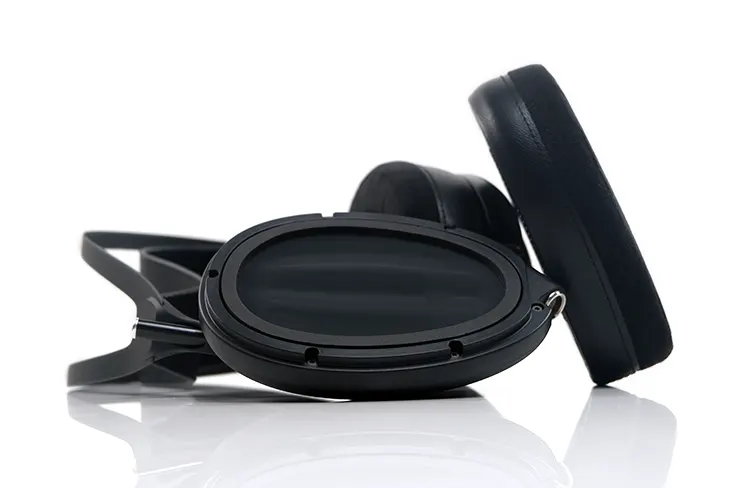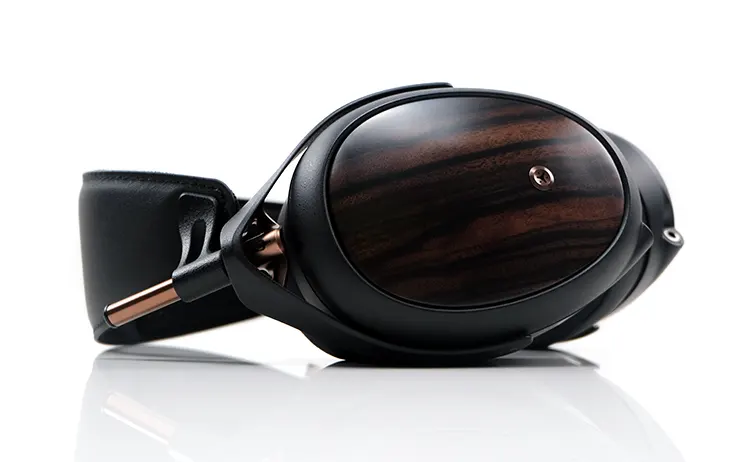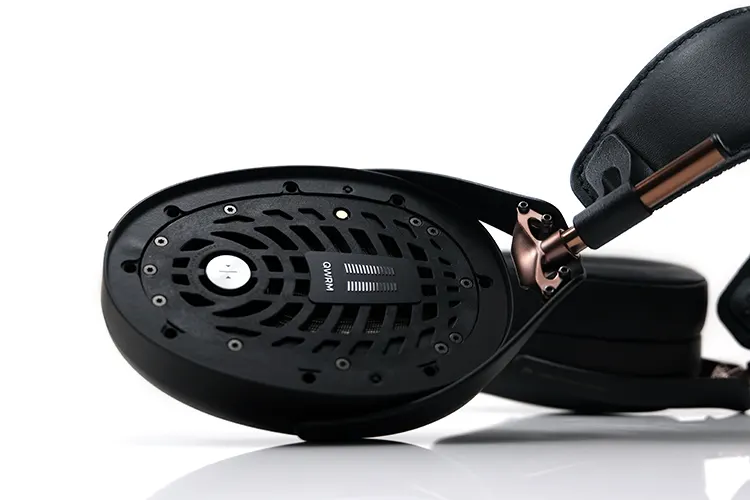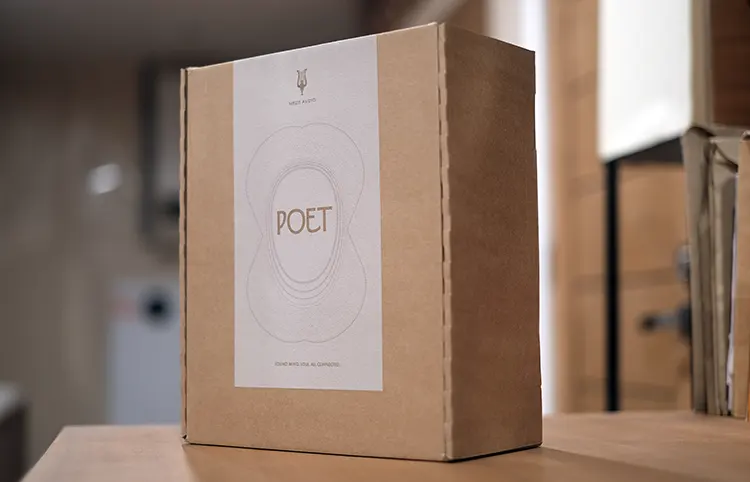Selected Comparisons
The following comparisons to the Meze Audio POET were completed using a mix of the Ferrum OOR/HYPSOS, WANDLA GSE desktop system, and a Cayin C9ii/iBasso DX320 MAX Ti transportable rig.
Meze Audio Elite
The Meze Audio Elite was launched in 2021, and my review was published shortly after. Though it is still classified as their flagship headphone, my sample is the original Silver launch model, whereas the currently available version is the Tungsten version.
Technical
Both are open-back isodynamic driver headphones with the same underlying switchback and driver coil design inherent in most of Meze Audio’s high-end offerings.
Meze has been quite open, mentioning that the POET MZ6 driver is a merger of the Elite MZ3SE and Liric MZ4 drivers, so we should expect some overlap despite the distinct nomenclature.
For example, both ovoid drivers are drawn from the Rinaro Parus diaphragm first seen in the Elite, the casing of each driver is fiberglass-reinforced polymer, and each uses a hybrid magnet array.
The devil is in the details in terms of how they truly differentiate from each other. For example, the Elite uses a larger 102 mm x 73 mm driver than the POET’s smaller 92 mm x 63 mm version with a roughly 25% larger active diaphragm surface area.
The Tesla strength rating of the Elite Magnets is also higher at 0.35T with a 12,7 N load compared to the POET’s 0.3T and 10,7 N load, indicating superior driver control.
The POET also introduces AMTS, formerly called QWRM from the Liric II, a quarter-wavelength resonator mask not present inside the Elite (original or Tungsten) for high-frequency tuning. One wonders if at some point this will change with any new Elite version down the road, though.
The POET is slightly higher on the load at 55Ω as opposed to the ELITE 32Ω impedance rating, but the SPL at 101 dB/mW @1kHz means the difference between either for volume matching from most sources will be negligible.
Design
I must caveat the design comparison by stating that the aluminum version of the Elite I have here is no longer available. If you buy it now, it’s a darker gunmetal color with a Tungsten finish, which I think I might prefer over the original silver.
Still, the basic form factor and design accents of the Elite are unchanged, meaning it’s different from the slightly simpler, but no less attractive, features of the POET.
I will start with aesthetics and maybe a hot take, but I prefer the bolder bronze and matte silver finish of the POET over the more traditional silver and black of the Elite.
I can see why they went Tungsten with the newer versions. For some reason, the og Elite’s brighter appearance feels out of sync with Meze’s more sultry visual design offerings.
The Elite is also a bigger headphone, though the comfort levels of both are as good, with slightly different approaches.
The Elite’s suspension wings design leather strap and slightly looser clamp combined with the bigger pad openings give it a roomier but slightly less secure feel on my head.
The POET has more lateral clamping, feels more snug around my ears, and has a reduced level of vertical pressure from its more regular wide body pressure strap.
It is a lighter headphone, especially with Nitinol rather than the bigger carbon fiber headband arches, and replacing the mini-XLR connectors in favor of smaller, lower profile 3.5mm connectors.
Overall, the POET’s weight distribution, smaller form factor, and secure lateral clamping give it more of a mobile feel than the homely Elite. It’s an open back, though, so there are limits to mobility, but it feels like a headphone with more flexibility.
Performance
I came to some surprising conclusions from this comparison. The first point should not be a surprising one. On a technical level, the bigger Elite driver produces a superior staging presentation.
I mean that in terms of more space, an improved and wider left-right stereo imaging experience, and a stronger perception of depth and separation. It creates a more immersive and holographic soundstage with better dynamic range than the tall and deep but narrower, flatter POET equivalent.
At times, the POET can struggle to sound as clear or as structured as the flagship Elite when hit with a wall of instruments. The Elite seems to handle each instrument placement with more ease as well as producing a more refined vocal performance.
It is less obvious if you play ambient synthwave or spare R’n’B tracks, but for midrange-heavy performances, the Elite is more adept at handling complex arrangements than the POET.
Tonally, I find the POET more neutral with less mid-bass bloo,m and that allows its sub-bass a shade more contrast and space to be heard.
It also has an uptick in upper-mids and lower treble presence from 4- 7k, which enhances midrange timbral contrast and brings a bit more energy to percussion strikes. The Elite is more subdued in this region.
As a result, I find the Elite a more euphonic, smoother listening experience, with a stronger presence on the lower-mids, but a slightly softer, easy-going tone and a little more decay on the lows.
Granted, the textured detail is better, but the POET lows can sound tighter. With less mid-bass bloom, you get a firmer picture of the sub-bass performance, which, I have to say, sometimes I prefer depending on the recording.
Meze Audio Empyrean II
The Empyrean II is the successor to the og Empyrean and was released in 2023. My review came out at the end of 2023, winning the Top Gear 2023 Awards Editor’s Choice for the same year.
Technical
The open-back Empyrean II essentially uses the same MZ3 Isodynamic Hybrid Array Driver as the original and is not one of the listed drivers from which the POET’s MZ6 is drawn.
That being said, this is an ovoid Rinaro driver, so there are some shared features, such as a dual-shaped voice coil array with switchback and spiral trace designs, hybrid magnetic arrays, and Isomagnetic ear cups.
So, where are the differences? Well, for one, the Empyrean II has a larger driver. At 102 mm x 73 mm with an active area of 4,650 mm2, it is on the same level as the Elite. Its casing is also fiberglass-infused ABS as opposed to reinforced polymer inside the POET.
The Empyrean II is also less sensitive than the driver inside the POET at 90 dB/mW compared to 101 dB/mW, making the latter a more portable source-friendly though it has a lower impedance value of 32Ω.
There is no quarter-wavelength resonator masking or AMTS technology inside the Empyrean II for high-frequency tuning, though the package does come with two choices of Duo ear pads that produce different sound signatures, Alcantara and leather.
Design
The Empyrean II form factor is the same as the Elite and bigger than the POET. The aesthetics are more in keeping with Meze’s darker approach to their headphone finishing with a matte black with small silver accents.
It is not as flashy as the bronze finish of the POET cup grills, but the ‘art deco’ mesh grooves are much more complex due to acoustical engineering requirements.
The choice of materials for the Empyrean II looks to be on a slightly higher level, also with the suspension wing,s design leather strap and carbon fiber headband frame. Mind you, I might prefer the lighter Nitinol of the POET for everyday use.
The POET is a narrower headphone to wear with more lateral pressure and more limited space inside the earpad, so it feels closer in application compared to the Empyrean II’s looser feel.
The Empyrean II mirrors the Elite wearing experience, though the new Duo pads Alcantara surface should mitigate any long-term sweating phenomena compared to the leather of the smaller POET pads.
My feeling here is the same as with the Elite. The Empyrean II is built strictly for home use, whereas the POET’s more compact form factor and slightly tighter clamp feel more adapted for mobility.
One final note on the cables. They come with the same Furukawa PCUHD copper cable, but you have options on the plug with the Empyrean II and an SPC version of the same cable at the checkout, whereas the POET is a fixed 6.35mm version.
Performance
At the risk of repeating my initial observation from the Elite comparison, the Empyrean II’s bigger driver delivers the bigger sound of these two headphones (with the Duo pads).
Its technical capability is superior to the POET, meaning a more immersive holographic and deeper soundstage with superior imaging and improved dynamic range.
The POET sounds reasonably tall and deeper,r but like the Elite comparison, it has a narrower, more intimate soundstage with slightly reduced vocal presence and a softer treble extension.
The Empyrean II also grabs some of the POET’s advantages over the Elite, such as a tighter set of lows, more contrast in the timbre, and a more excitable set of highs.
Of all of the headphones I compared, I would argue the Empyrean II’s tonal coloration is the most accurate, save for some exuberance in the highs.
Of the two, its presentation is more dynamic sounding and not as warm as the POET, especially with its stronger 2-8k elevation, which, ironically, the POET mirrors a bit but with several dB less amplitude.
I find the POET a little smoother sounding with similar recordings, with less treble brilliance though by no means treble shy, with some nice fill in the 4-7k range.
The POET also has less bass bloom from 80-500Hz, so the sub-bass performance is still quite well defined and competitive compared to the Empyrean II.
I also found the POET’s lower-mids were not as dipped-sounding from 500hz up to 1k, which is why, in my original Empyrean II review, I mentioned it has a slight V-shaped influence in its tuning.
Meze Audio Liric II
The Meze Audio Liric II was launched last year, with my review published around the same time. It has the same price point with some perhaps considering the POET the open-back equivalent.
Technical
There is a lot of commonality between these two headphones for the driver, though the most salient difference is the closed-back design of the Liric II as opposed to the POET’s open-back construction.
For nomenclature’s sake, the Liric II uses a Rinaro Isoplanar MZ4 isodynamic hybrid driver with the POET’s MZ6 drawn from the Elite’s Parus diaphragm design.
These are similar-sized drivers at 92 mm x 63 mm and an active area of 3,507 mm2, though the THD of the POET driver measures a bit lower than the Liric II version.
The Liric II driver also has a lower impedance level of 61Ω rather than 55Ω with the POET 1 dB/mW more sensitive.
Both use quarter-wavelength resonator masking or AMTS technology for high-frequency tuning, by the way, though the Liric II version, when launched, was called QWRM.
When detaching their magnetic cups, you can see a similar ‘barrier’ on the front of the driver, though the POET version is a little lower in its placement than the Liric II version.
Given that the Liric II is a closed-back, it also has additional airflow control with Meze’s PES technology, first seen in the Advar and then expanded to the Liric line of headphones.
Design
The design language and the form factor are very similar. However, the aesthetics and comfort levels of the POET are superior to my eyes and head.
Granted, a closed-back design is never going to be quite the same, but those striking copper mesh grills on the POET are more eye-catching. Some will prefer the softer wood grain veneer visual of the Liric II cups, but it’s not as striking as the POET when placed side by side.
The Nitinol headband system also kind of gets out of the way of everything, whereas the POET uses a more ‘present’ single, padded headband structure rather than a pressure-relieving strap system.
I find both headband systems equally comfortable, but the POET version feels lighter on the top of my head, so it gets my vote.
Perhaps the most important comfort-related difference is the inner cavity difference between the two detachable earpad systems. The Liric II earpad inner walls are tighter to the ear, slightly smaller in dimension, and do not clear the ear as well as the POET version.
The pads are the same hybrid leather and Alcantara inner, so the sweat performance should be somewhat similar. Rather, it’s the prolonged pressure from the Liric II pads directly on your ear that makes the difference.
Both headphones use a 3.5mm connector system on the base of the cups, and a Furukawa PCUHD cable is included. However, the Liric II is terminated with a 4.4mm plug, whereas the POET is 6.35mm. I would have stayed with 4.4mm for the POET given modern amps’ increasing use of 4.4mm outputs.
Performance
There is room in the inn for both of these headphones’ sound signatures, it just depends on your preferences.
For example, I find the POET to sound airier, with an easier flow and better note dissipation, consistent with an open-back acoustical design.
Its tuning has a more balanced set of lows, not as exaggerated on the bass shelf up to 100hz but with slightly more upper-bass and lower-mids presence than the Liric II.
The Liric II feels slightly more walled-in for staging, as you might expect for a closed-back. However, within that wall, it’s the more powerful and aggressive sound signature with denser lows and a more prominent vocal imaging experience.
When the Liric II bass gets moving, it can dominate the sound signature, though not to the same extent as the original Liric Gen 1. The POET sounds more controlled on the lows, giving it more flexibility.
The Achilles heel of the Liric II is the lower treble tuning, which is more elevated from 4-7k. Though not as exaggerated as the original Liric tuning for sharpness, it lacks the same sweetness and balance as the POET.
Sibilance is more prominent from the Liric II’s vocal timbre, whereas the POET tonal coloration is slightly sweeter. Again, it adds to that smoother listening experience from the POET I mentioned at the start.
My Verdict
The Meze Audio POET is a beautifully designed set of open-back headphones, complete with the company’s trademark penchant for excellent comfort.
Of all the Meze headphones, the POET comes closest to capturing some of the spirit of the original Empyrean’s tuning. And yet it retains its own identity with a generally smooth sound signature, a dash of treble sparkle, and a slightly flatter bass response that creates a nicely balanced tonal quality.
Whilst it might lack a little in staging space and technical capability compared to the flagship offerings, it provides more refinement and superior listening flexibility over the more aggressive and weightier closed-back Liric II presentation.
Consider this the more chilled and airy sibling of the Liric II. If you need outright power and in-your-face performances, the closed-back is the better choice. But for everything else, then the POET gets my vote.
Meze Audio POET Technical Specifications
- Driver Type Rinaro Isodynamic® Hybrid Array MZ6
- Geometrical Shape Ovoid
- Operating Principle Open-Back
- Size 92 mm x 63 mm
- Ear Coupling Circumaural
- Driver Weight 73 g (2.5 oz.)
- Frequency Range 4 Hz – 96 kHz
- Casing Fiberglass Reinforced Polymer
- Impedance 55 Ω
- Diaphragm Type Rinaro Parus® MZ6
- Sensitivity 101 dB SPL/mW at 1 kHz
- Active Area 3,507 mm2
- Maximum SPL >130 dB
- Diaphragm Weight 0.06 g
- Total Harmonic Distortion (THD) <0.05%
- Acoustic Mass 6.5 kg/m4
- Weight 405 g (14.29 oz)

